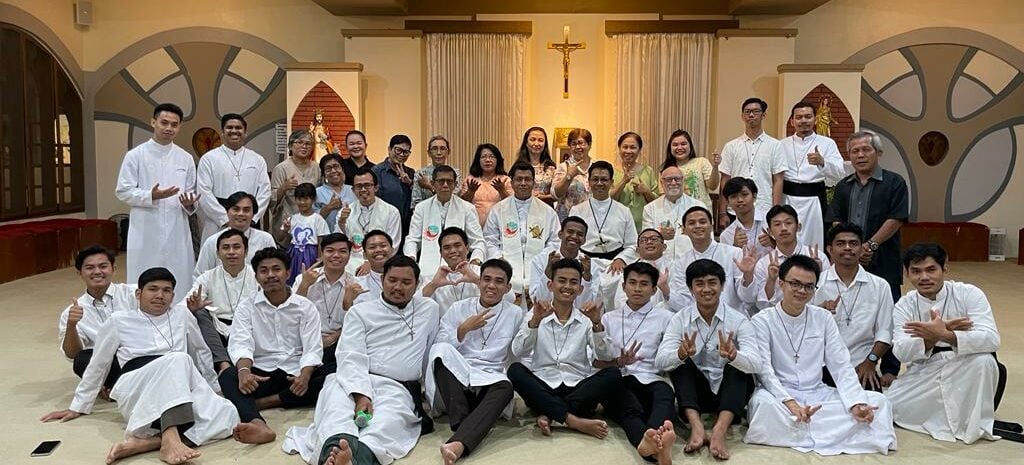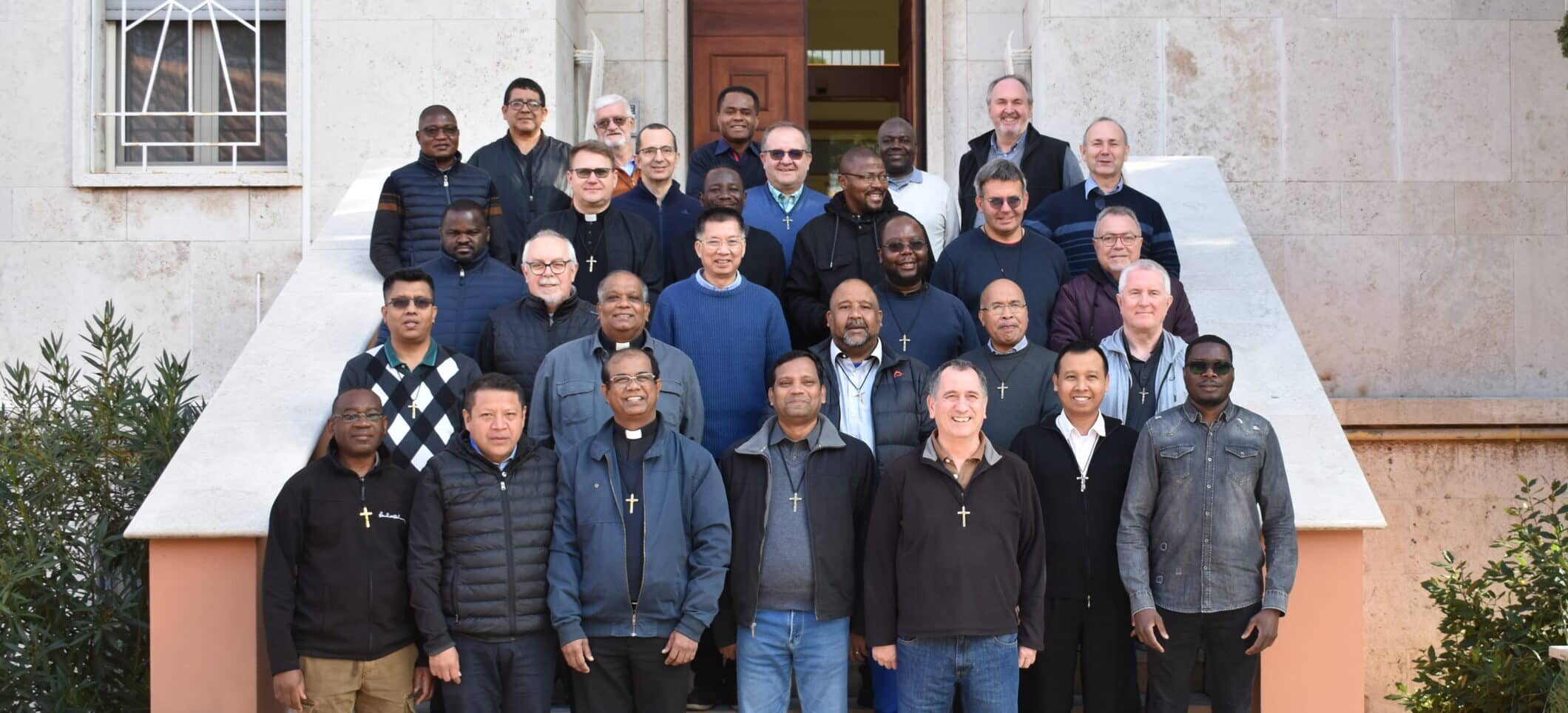Pasquale CASTRILLI, OMI
17 Oblates attend the conference organized by the European Mission Committee for the Oblates who serve in the pastoral care of shrines in Europe.
The commitment of the Missionary Oblates of Mary Immaculate in shrines is still relevant. This was highlighted by a conference held in Lourdes from 20-23 November on the theme: “Shrines, places of evangelization. Honoring the past, responding to the present, with hope towards the future.” The conference, promoted by the European Mission Committee (EMC), was attended by 17 Oblates from Ireland, Norway, Belgium, Luxembourg, France, Poland and Italy.
Conference themes
The thematic contributions offered excellent ideas. Bernard DULLIER, connected via ZOOM from Aix-en-Provence, discussed the topic “Eugene de Mazenod and shrines, a historical perspective”. Bernard recalled the reasons why the shrines of Notre Dame du Laus and Notre Dame de l’Osier were accepted by Saint Eugene de Mazenod. “The sight of concrete situations provokes a ‘missionary reaction’ in Eugene,” he said, adding, regarding the first Oblate community outside Aix-en-Provence, “after years of study, I believe I can affirm that the true birth of the congregation was at the moment in which Eugene accepted the shrine of Notre Dame du Laus”. According to DULLIER, there were three points that led the Founder to accept the shrines: “Evangelizing the most abandoned souls; the glory of the Virgin Mary; giving a better direction to the devotion of the faithful”.

Bernard DULLIER, OMI
In the talk entitled “Oblate charism and pastoral care in shrines”, Mark KEMSEKE, a Belgian Oblate, underlined that pastoral care in shrines is a “permanent mission and a ministry of compassion”. Mark recalled the key points of the Oblate charism and, in the final part of his conference, asked himself the question: “What do pilgrims have the right to expect from the Oblates at the shrines?”, while looking for an answer starting from his long experience as a chaplain in Lourdes.
Finally, the rector of the Lourdes shrine, Father Michel Daubane, presented a reflection on the theme: “The role of shrines in today’s church. The thoughts of Pope Francis.” He made extensive references to the meeting held in the Vatican from 9-11 November for the rectors and pastoral workers of shrines. Comforting the pilgrims; strengthening their faith; allowing everyone to look to the future with hope: these were the three points that he proposed in his reflection. Father Daubane concluded by leaving some questions open. “What is the commitment in shrines to educate popular piety? How to live the ministry of ‘comfort’ which is sometimes difficult? What formation and what regular reading should we propose to the confessors working in the shrines?”.
A second point of attraction was the return to the Oblate history of origins. Everyone was happy to listen to Bernard DULLIER and Mark KEMSEKE who recalled the beginnings of the Oblate congregation starting from the first Oblate community outside Aix-en Provence, established in 1818 in the sanctuary of Notre dame du Laus, diocese of Gap. Although the commitment to shrines was not present in De Mazenod’s very first intentions, this was in fact the ministry of the OMI missionaries which, in the first decades of the congregation, they supported and integrated with that of itinerant missions.
Two points of interest
The participants at the Lourdes Conference felt challenged above all by two questions. First of all, the theme of the formation of confessors, also mentioned by Pope Francis in the audience of last November 11th to the participants in the International Meeting of Rectors and Operators of Shrines at the Vatican: “I recommend that, in the choice of priests for confessions, there should be good discernment, so that it does not happen that those who come to the confessional, attracted by the Father’s mercy, encounter obstacles to experiencing true and full reconciliation. The Sacrament of Reconciliation is to forgive, always. To forgive. It cannot happen, especially in shrines, that they find obstacles; no, it cannot happen, because in them God’s mercy demands to be expressed in a superabundant way, by its very nature.” This topic was discussed in the groups, with the rector of the Lourdes shrine and with Don Bernardino Giordano of the Loreto shrine who was among the participants in the conference. Pope Francis invites shrines to prepare confessors and to choose suitable confessors who can welcome, console and bless.
Space was reserved, during the days of the conference, for sharing and prayer. Oblate fraternity is always an important dimension of these European meetings. Last year the European Mission Committee met at Nikolauskloster near Dusseldorf in Germany. The joy of meeting, of sharing, but also of edifying one another in the search for ways to evangelize in the European context, were also important dimensions of this congress.
The impressions of the participants
“A very rich history of the Oblates in shrines,” says Martin MORAN, Oblate of the Inchicore shrine in Dublin. “I notice a call to keep things simple; shrines are a fantastic place to help people and re-encounter Christ. I find that in the ministry in the shrines there are great signs of hope.”
Roman TYCZYŃSKI from Luxembourg asks: “How can we orient this ministry into the future? Shrines are places of permanent mission: [let us] be faithful to this notion that we inherited from our Founder. Regarding popular piety, it is sometimes said that it must be abandoned, but I find that popular expressions are important. The Founder said that we must be close to the people and to transmit the gospel, it was necessary to speak an understandable language: the Provençal dialect”.
Vincent GRUBER, who is starting his service at the shrine of Pontmain in France, saw in the conference a providential moment. “This meeting was an immense gift to focus on the issue of shrines,” he said. “I took this meeting as a sort of program, with some points for my attention. In the shrines, there are many people who need God. The beauty of the liturgy: people need signs. And we Oblates are the specialists of signs in preaching.”
Grzegorz GLABAS of the shrine-parish of the Immaculate Conception in Aosta in Italy spoke about the role of the laity in the pastoral care of shrines, while Jagath GUNAPALA, an Oblate in Norway, and Mariusz BOSEK of the shrine of Koden in Poland, reflected on the pastoral care of vocations and the challenges of the pastoral care of shrines starting from the world of youth.
Jean-Georges ZYILHOUBE from France underlined the value of sharing to allow ourselves to be “enlightened by the vision of our Founder in our Oblate pastoral commitment in the shrines”. And he noted that through the Lourdes conference, “we have received encouragement in our workplaces. We also had new ideas about this ministry and perhaps recovered some enthusiasm. We have realized that shrines are privileged places of evangelization today.”



